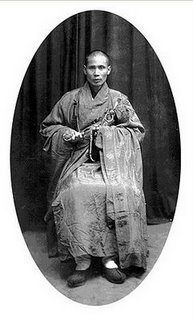Views
Chísōng 持松 (1894-1972)
|
| Notable Associates: |
|
Chísōng 持松 (1894-1972) was a famous teacher of Esoteric Buddhism 密宗 during the Republican period.
Contents |
Biography
Chísōng began attending a Confucian academy when he was 6. When he was 14, his father died, and two years later a flood forced his mother to give him to a family member to raise. He took tonsure at age 17 (1910) at Tiěniú Temple 鐵牛寺 in Jīngzhōu 荊州, after which he traveled to Yuǎn‘ān County 遠安縣 (Húběi) to study Buddhism.
In 1912 Chísōng received the full precepts at Guīyuán Temple 歸元寺 in Hànyáng 漢陽. Later that year, he traveled to Shànghǎi to enroll at Huáyán University 華嚴大學. When the school moved to Hángzhōu 杭州 three years later, Chísōng went along. There he worked closely with the school's founder, Yuèxiá 月霞 before graduating in 1916. Upon graduation he returned to his hometown, but his family was all dead or lost. He studied Tiāntái 天台 at Yùquán Temple 玉泉寺 in Dāngyáng 當陽 under Zǔyìn 祖印.
In 1917 Chísōng attended lectures given by Yuèxiá at Guīyuán Temple and Bìshān 碧山 in Yíxīng 宜興, before following Yuèxiá to Xīngfú Temple 興福寺 in Chángshú 常熟, when Yuèxiá became abbot there. On July 1, Chísōng was appointed the official recorder 書記, while another of Yuèxiá's disciples, Yīngcí 應慈 was asked to organize the Dharmadhatu Seminary 法界學院 at the temple. Sadly, Yuèxiá died in Hángzhōu that fall before any of these plans was brought to fruition.
In February 1918, Yīngcí, acting on the request of the late Yuèxiá, transmitted the dharma to Chísōng, Hùizōng 惠宗, and Tányuè 潭月, making them all 43rd-generation holders of the Línjì 臨濟 lineage. The Dharmadhatu Seminary went ahead, and from 1920 to 1922, Chísōng lectured on the Śūraṃgama Sūtra there. In 1922, he was asked by Chángxǐng 常惺 to come lecture at the Ānhuī Monastic School 安徽僧學校 at Yíngjiāng Temple 迎江寺 in Ānqìng 安慶.
While at the Monastic School, Chísōng became interested in studying Esoteric Buddhism 密教. In the fall of 1922, he and Dàyǒng 大勇 traveled to Koya-san 高野山 in Japan to study Shingon 真言 Buddhism. In 1923 he received abiṣeka 灌頂, or esoteric initiation, earning him the rank of a 51st-generation Ācārya 阿闍梨. He returned to China the same year. Upon his return, he and Dàyǒng traveled to Wǔhàn 武漢, where, based at the Wuchang Buddhist Seminary 武昌佛學院, they gave abiṣeka to many Buddhists. Shortly thereafter, Chísōng gave abiṣeka to about one-hundred Buddhists at Hángzhōu's Pútí Temple 菩提寺.
After this, he traveled between Wǔhàn and Ānqìng before becoming abbot of Bǎotōng Temple 寶通寺 on Hóngshān 洪山 in 1924. This eventually became an important site for the transmission of Japanese Esotericism 東密. The fall of his arrival, Chísōng performed a Nation-Saving Dharma Rite for Humane Kings 仁王護國法會 for the local army. At that ceremony he gave abiṣeka to several thousand people, including several famous lay Buddhists from Wǔhàn, Chén Yuánbái 陳元白, Zhào Nánsān 趙南三, Dù Hánsān 杜漢三, and Dèng Mèngguāng 鄧夢光.
In 1925 Chísōng was part of the Chinese Delegation to the East Asian Buddhist Conference 東亞佛教大會. He stayed in Japan for an additional two years in order to receive further instruction from his teachers at Koya-san. He returned to China in 1927. Upon his return, he lectured at various locations in Shànghǎi 上海.
After Bǎotōng Temple was destroyed during the Northern Expedition, Chísōng spent several years traveling and lecturing in the Jiāngnán 江南 area. After 1931, Wáng Yītíng 王一亭 and other Shanghainese laymen established the Bodhi Study Association 菩提學會 for the study of Esoteric Buddhism. Chísong was asked to be the guiding teacher of the group, which set up shop in the Meditation Hall 靜室 of the Pure Karma Society 淨業社. Chísōng also taught various mudrās at the Qīngliáng Temple 清涼寺 the behest of Jiǎng Wéiqiáo 蔣維喬.
In 1936 Chísōng returned to Japan once more. After he came back, he moved to Shèngxiān Temple 聖仙寺, where he went into seclusion during the Second Sino-Japanese War. During this time he published a number of works, and much of his publishing was financed by Liza Roos 羅迦陵. In 1947, after the end of the War, Chísōng became abbot of Jìng'ān Temple 靜安寺 and the head of the Jìng'ān Buddhist Seminary 靜安佛學院, both in Shànghǎi. Chísōng held a Tang-style esoteric rite at Jìng'ān Temple in 1953. In 1954 he was elected a representative for Shànghǎi. In 1956 he was made the president of the Shànghǎi Branch of the Chinese Buddhist Association 中國佛教協會. In November of that year he traveled to Nepal for the fourth International Buddhism Conference.
He, his temple, and his monks all faced persecution during the Cultural Revolution. He died on November 16, 1972.
Important Works
- Much of his work is available online at 持松法師研究網
Notable Students
Notes
References
- Yú Língbō 于凌波, ed. Xiàndài Fójiào rénwù cídiǎn 現代佛教人物辭典 (A Dictionary of Modern Buddhist Persons), 2 vols. Taipei: Foguang, 2004. Pp. 1:754c-757b.
